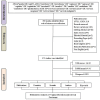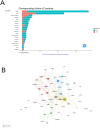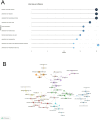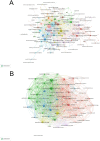Vaginal bacteria and cervical cancer: a bibliometric analysis of trends and themes
- PMID: 40809054
- PMCID: PMC12343664
- DOI: 10.3389/fmicb.2025.1615944
Vaginal bacteria and cervical cancer: a bibliometric analysis of trends and themes
Abstract
Background: Cervical cancer remains a significant global health challenge, with increasing evidence suggesting the crucial role of vaginal bacteria in its development and progression. This study aims to analyze the global research landscape and trends in vaginal bacteria and cervical cancer research through bibliometric analysis.
Methods: Literature data were retrieved from the Web of Science Core Collection (WOSCC) database. Bibliometric analysis was performed using VOSviewer, CiteSpace, and R-bibliometrix to evaluate publication patterns, research collaboration networks, and emerging trends.
Results: A total of 372 publications were identified, showing an annual growth rate of 8.41%. China and USA emerged as leading contributors, with the Imperial College London and University of Arizona being the most productive institutions. Herbst-Kralovetz MM and Laniewski P were identified as the most influential authors, while BMC Infectious Diseases and Frontiers in Cellular and Infection Microbiology were the primary publication venues. Keyword co-occurrence analysis identified "bacterial vaginosis," "women," and "inflammation" as the most frequent terms, while burst detection revealed emerging research trends in "lactobacillus," "intraepithelial neoplasia," and "16 s rRNA gene sequencing."
Conclusion: This bibliometric analysis provides comprehensive insights into the evolution and current status of vaginal bacteria research in cervical cancer, highlighting key research themes and collaborative patterns. These findings offer valuable guidance for future research directions and potential clinical applications in cervical cancer prevention and treatment strategies.
Keywords: CiteSpace; VOSviewer; bacterial vaginosis; bibliometric analysis; cervical cancer.
Copyright © 2025 Liu, Zhao, Meng, Gao, Wang and Yang.
Conflict of interest statement
The authors declare that the research was conducted in the absence of any commercial or financial relationships that could be construed as a potential conflict of interest.
Figures








Similar articles
-
A bibliometric analysis of research trends in mesenchymal stem cell therapy for neonatal bronchopulmonary dysplasia: 2004-2024.Front Pediatr. 2025 Jun 3;13:1558301. doi: 10.3389/fped.2025.1558301. eCollection 2025. Front Pediatr. 2025. PMID: 40530182 Free PMC article. Review.
-
Data-driven trends in critical care informatics: a bibliometric analysis of global collaborations using the MIMIC database (2004-2024).Comput Biol Med. 2025 Sep;195:110670. doi: 10.1016/j.compbiomed.2025.110670. Epub 2025 Jun 27. Comput Biol Med. 2025. PMID: 40580617
-
Driving innovations in cancer research through spatial metabolomics: a bibliometric review of trends and hotspot.Front Immunol. 2025 Jun 10;16:1589943. doi: 10.3389/fimmu.2025.1589943. eCollection 2025. Front Immunol. 2025. PMID: 40557160 Free PMC article.
-
Trends and hotspots in global influenza and intestinal flora research based on bibliometrics.Front Microbiol. 2025 Jul 28;16:1630924. doi: 10.3389/fmicb.2025.1630924. eCollection 2025. Front Microbiol. 2025. PMID: 40792264 Free PMC article.
-
Application of non-invasive imaging in myocardial infarction: a bibliometric analysis from January 2003 to December 2022.Quant Imaging Med Surg. 2025 Jul 1;15(7):6340-6359. doi: 10.21037/qims-24-878. Epub 2025 Jun 30. Quant Imaging Med Surg. 2025. PMID: 40727351 Free PMC article.
References
-
- Arbyn M., Kyrgiou M., Simoens C., Raifu A., Koliopoulos G., Martin-Hirsch P., et al. (2008). Perinatal mortality and other severe adverse pregnancy outcomes associated with treatment of cervical intraepithelial neoplasia: meta-analysis. BMJ 337:a1284. doi: 10.1136/bmj.a1284, PMID: - DOI - PMC - PubMed
-
- Aria M., Cuccurullo C. (2017). Bibliometrix: an R-tool for comprehensive science mapping analysis. J. Informetr. 11, 959–975. doi: 10.1016/j.joi.2017.08.007 - DOI
Publication types
LinkOut - more resources
Full Text Sources

